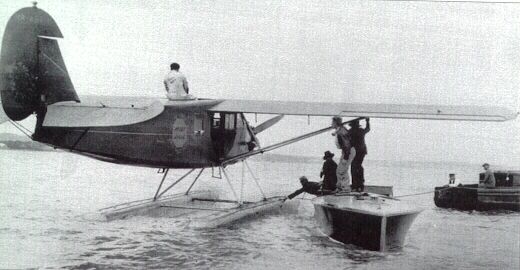|
Stinson Flight to Bermuda,
1930
from The Flying Boats of Bermuda by
Colin A. Pomeroy
Added April 17, 2001

Stinson SM-1FS "Pilot Radio",
Hamilton Harbor, Bermuda, April 2, 1930
On a family vacation to Bermuda
in April, 2001, I learned a new piece of Stinson history that I had not
seen recorded elsewhere. The first successful aircraft flight to
Bermuda from the United States occurred in April, 1930. The plane
was a Stinson SM-1FS "Detroiter".
I came across this footnote
to Stinson history while reading a new book, "The Flying Boats of Bermuda"
by Colin Pomeroy, published in 2000. For anyone interested in the history
of aviation in Bermuda, particularly in the history of marine aviation,
this comprehensive history is recommended. The book details the early
years of marine aviation in Bermuda, the years of civil flights in large
trans-oceanic flying boats, the military presence during World War II,
and even the last recorded marine aviation activity in Bermuda - a Cessna
172 on floats that flew in from Connecticut in 1987.
Mr. Pomeroy, a retired Royal
Air Force Squadron Leader and airline captain, describes the first unsuccessful
attempt to fly from the US to Bermuda in 1928 and then goes on to detail
the first successful flight in a Stinson Detroiter in the following excerpt
from his book:
"It was to be almost another two years before a successful flight between
the mainland and Bermuda was finally achieved, this being when the Stinson
monoplane Pilot Radio, sponsored by a US radio station, made the
crossing. (Ironically, despite satisfactory communications with other ground
stations, the aircraft - allocated the wireless call sign 2XBQ - never
established airborne contact with its sponsor.) Pilot Radio
was a customized Stinson SM-1FS 'Detroiter' aircraft, fitted with a 300
hp Wright J6 engine and mounted on a pair of EDO floats. It had a
top speed of 118 mph (190 km/hr), a cruising speed of 100 mph (160 km/hr)
and a standard cruising range of 550 miles (880 km) - which, even in its
modified state, left little margin for error.
The crew,
Captain Lewis Yancey (first pilot and lead navigator), Lieutenant William
alexander (co-pilot) and Lieutenant Zeh Bouck (radio operator) set off
from New York at 9.39 am (EST) on the morning of Monday 1st April 1930,
planning to reach their destination in just eight hours. However,
stronger than forecast headwinds were encountered and, running short of
fuel and with darkness falling, the fragile craft alighted on the sea some
60 miles short of Bermuda at 5.59 pm, having first advised one of the land
stations monitoring its progress of this course of action. The sea
was calm and the unscheduled landing was more of an inconvenience than
an emergency; nevertheless, the St George wireless station stayed on watch
throughout the hours of darkness in case its help was needed and the Canadian
Steamship Company's Lady Somers turned back to the landing position
to assist if required but, finding no help was needed, resumed her passage
to Halifax soon afterwards.
At 6.45
am (Bermuda time) the next morning, Pilot Radio once more took to
the air - itself no mean achievement in the heavy swell which had come
up overnight - and after only 35 minutes Bermuda was sighted on the horizon.
The aircraft's fuel situation was by now becoming critical, so they put
the seaplane down once more - this time off North Rock, where some fuel
was obtained from the Darrell brothers who were out fishing at the reef.
At 7.15 am the little monoplane touched down at Murray's Anchorage, where
further fuel was brought out from St George to aviators by Messrs E Tucker
and W Meyer and, finally, the fourth touchdown of the epic flight was made
at 8:00 am in Hamilton Harbour, after which Pilot Radio was towed
to a mooring - initially by the 6 metre yacht The Thalia, but later
by a harbour launch.
Yancey,
Alexander and Bouck had intended to return to New York in the seaplane.
On the morning of Saturday 5th April Major Kitchener, in whose Hinson's
Island hangar it had been stabled, accepted an invitation to fly in the
aircraft with Richardson; unfortunately on the after-flight inspection
of Pilot Radio some damage was discovered in one of the stays joining
the floats to the main fuselage. This problem, which could not be
easily resolved in Bermuda, coupled with the shortage of fuel of a suitable
octane for the engine, gave the crew little option but to abandon the return
flight and dismantle Pilot Radio for a return passage to the United
States on the next Furness Line cruise ship."
Special thanks to Mr. Colin Pomeroy
for his informative and entertaining book and for the permission to excerpt
this piece on the flight of the Pilot Radio. If you would like to
order a copy of the book, you can do so by contacting:
1. For US $ orders: Print Link Ltd, PO Box HM 937, Hamilton HMDX,
Bermuda.
The cost is $27.50, plus $5 air-lifted mail - please make your check payable
to Print Link Ltd.
2. For sterling orders: C A Pomeroy, Pallington Lakes, Pallington,
Dorchester, DT2 8QU, England.
The cost is £17.25, plus £5 for airmail or £2 for surface
mail. Please make
your cheque payable to C A Pomeroy.
Back
to the main Stinson page
Back
to the Hangar 9 Aeroworks Main Page
|
